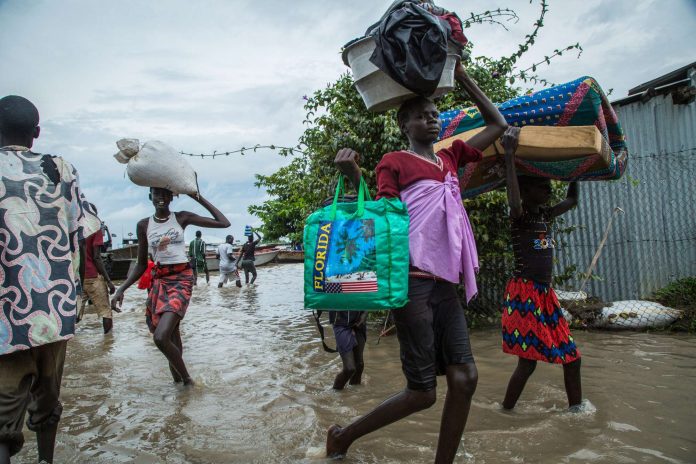Facebook Twitter (X)
South Sudan is poised to confront a deadly combination of floods and famine, prompting NGOs to issue urgent alerts. Save the Children warns that the country, known as the world’s youngest, faces its worst flooding in six decades, which threatens to push parts of the nation to the brink of famine. This prediction follows recent data from the Famine Early Warning Systems Network (FEWS NET), highlighting an imminent humanitarian crisis from June 2024 to January 2025.
Looming Peril from the Oncoming South Sudan Floods and Famine
The child advocacy group underscores the looming peril of widespread hunger among children in South Sudan, exacerbated by prolonged conflict, food insecurity, rising prices, past floods, and an influx of refugees and returnees from Sudan’s ongoing 15-month conflict. Despite a peace agreement in 2018, South Sudan continues to grapple with one of the world’s severest humanitarian emergencies, affecting approximately 9 million people, or 75 per cent of the population, with nearly 5 million children in dire need of aid.
Unity State, particularly susceptible to flooding due to its low-lying geography, is identified as especially vulnerable to famine. The region previously experienced famine conditions in early 2017, narrowly averted by swift humanitarian intervention.
Cause of the Oncoming South Sudan Floods and Famine
The looming famine is expected to be driven in part by anticipated severe flooding, surpassing the scale of floods witnessed in 2020 and 2022. Water levels in Lake Victoria, a key Nile source, have reached a 128-year high, prompting South Sudan’s government to issue warnings of extensive flooding by late 2024. FEWS-NET estimates that over 65,000 square kilometers of land could be affected equivalent to Sri Lanka’s entire area.
Save the Children’s South Sudan Country Director, Pornpun Jib Rabiltossaporn, describes a dire scenario where floods will isolate entire communities from aid, hindering families’ ability to travel for food or income for months. With existing high levels of malnutrition and hunger among children, compounded by conflict-related displacement and refugee influxes, Save the Children emphasizes the urgent need for increased funding and preparation to mitigate the impending catastrophe.
“While floods are part of life for families in much of the country, we are seeing a situation where the floods will be so extreme over such vast patches of land that entire communities will be marooned from assistance.”
“With already extreme levels of hunger and malnutrition in children across South Sudan and a massive conflict over the border forcing hundreds of thousands of people into crowded refugee camps, in all likelihood we will see children start to die from hunger-related illnesses as the flooding takes hold.
Response Plan for the Floods and Famine
“Save the Children is urgently finalizing its flood anticipatory and response plan, preparing communities, and prioritizing the most vulnerable high-risk locations. However, the alarm isn’t being heard widely enough. There are imminent disaster-threatening communities in South Sudan. Unless there is an urgent scaling up of funding for preparation work, the upcoming floods are guaranteed to wreak havoc. We are going to see a large number of homes destroyed, roads and low-lying settlements flooded, and monumental levels of hunger.”
In neighboring Sudan, where conflict persists with no signs of abating since April of the previous year, over 700,000 people have sought refuge in South Sudan, exacerbating local food shortages and straining resources.
Beyond Unity State, other vulnerable areas like Jonglei, Northern Bahr el Ghazal, Upper Nile, and Warrap states are also at risk from the projected flooding. Many residents in these regions are already vulnerable due to previous floods, ongoing conflict, displacement, food insecurity, and the influx of refugees and returnees from Sudan.
Save the Children, operational in South Sudan since 1991, provides crucial support, including education, healthcare, nutrition, and livelihood assistance, to affected children and families. In 2023 alone, their programs reached over 1.9 million people, including 1.1 million children, with plans to assist 1.4 million individuals this year.
Read more:
South Sudan on the Brink of Famine as it Braces for Worst Floods in 60 Years | Save the Children

